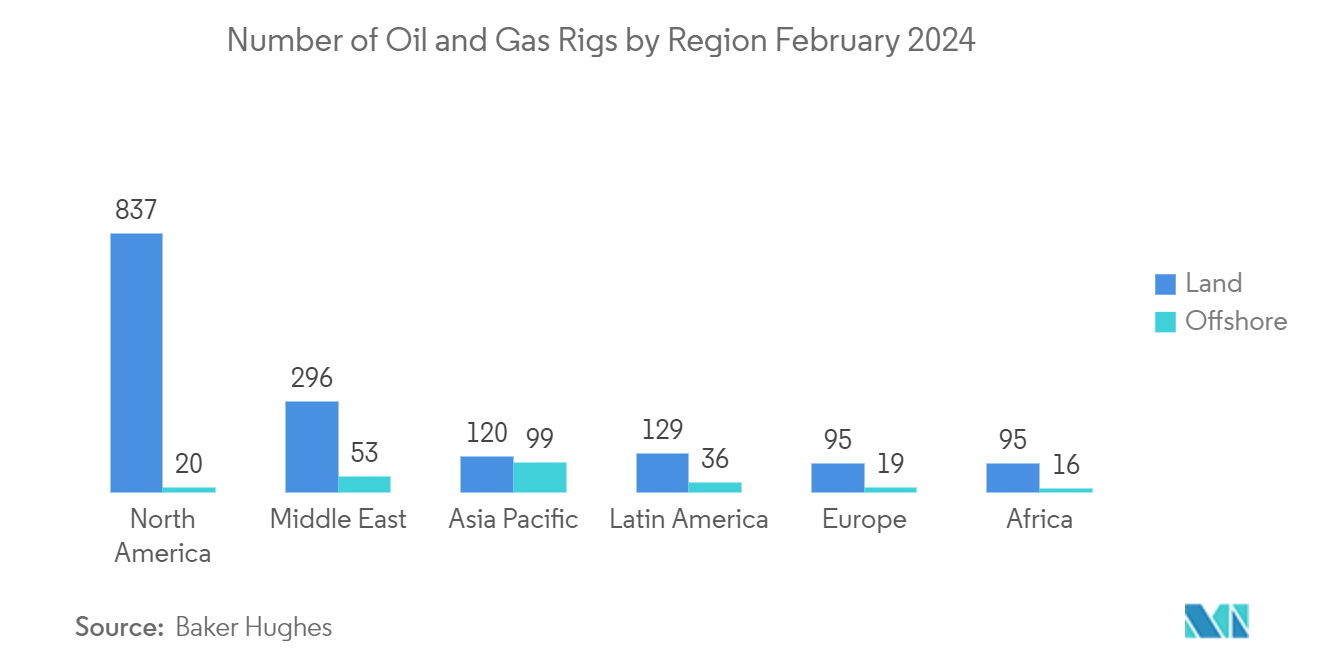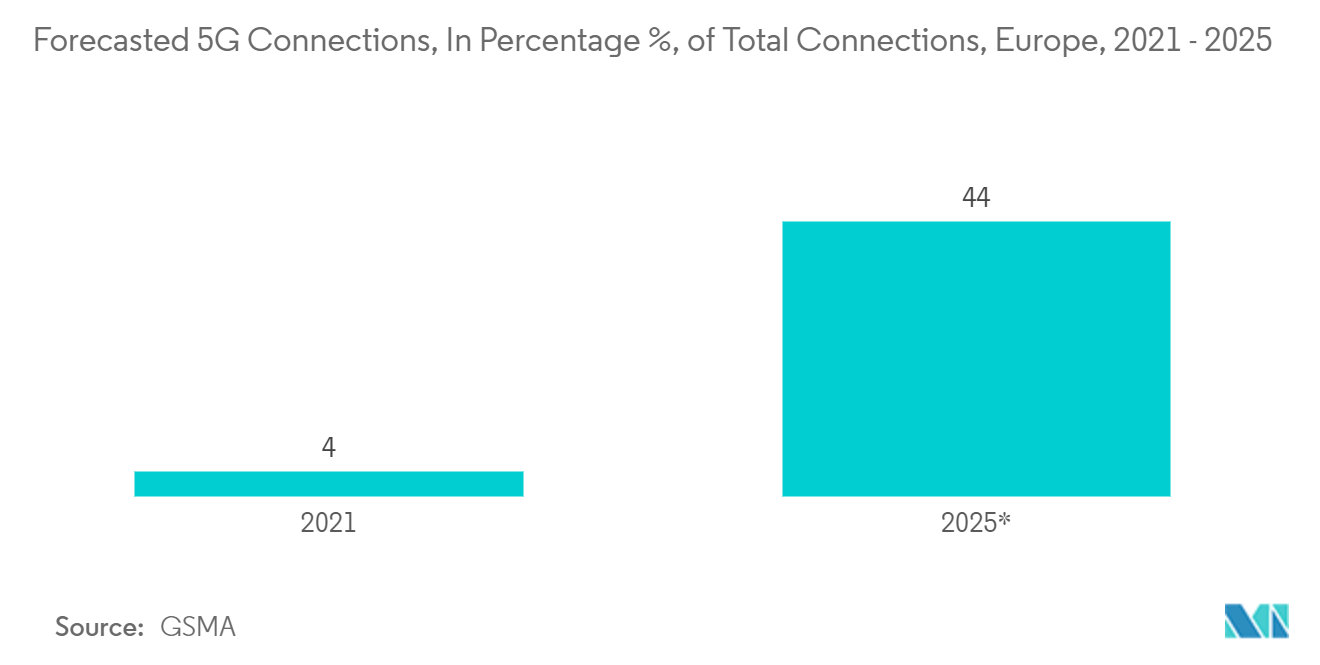Market Trends of EMEA Mission Critical Wireless Communications Industry
Oil and Gas Industry to Hold Major Share in the Commercial and Industry End User Segment
- The oil and gas industry in the EMEA region heavily relies on mission-critical wireless communications to ensure seamless operations, enhanced safety measures, and efficient production processes. Across Europe, the Middle East, and Africa, this vital sector leverages various communication technologies tailored to the specific demands of oil and gas operations, including both onshore and offshore facilities. As a result, these communication systems play a crucial role in facilitating reliable and uninterrupted communication between personnel, equipment, and control centers, thereby enhancing operational efficiency, safety protocols, and emergency response capabilities in the oil and gas sector.
- The industry's complex operations necessitate robust and reliable communication systems to ensure the safety and security of personnel, assets, and the environment. Mission-critical wireless communications enable real-time monitoring, emergency response, and efficient coordination, enhancing overall safety and security measures. By providing seamless and uninterrupted communication channels, these systems might help mitigate potential risks and ensure quick responses to critical incidents during exploration, production, or distribution processes.
- Moreover, according to the Energy Institute, the Middle East produces more substantial volumes of oil than any other region. For instance, According to Baker Hughes, the Middle East is home to some of the highest numbers of oil and gas rigs in the world. In February 2024, there were a total of 349 land rigs in that area.
- As a result, the region's prominent position as a significant oil-producing hub emphasizes the critical importance of robust communication infrastructure in the oil and gas sector. With a substantial share of the world's oil production originating from the Middle East, the need for efficient and reliable mission-critical wireless communications becomes increasingly crucial.
- In the Middle East, the oil and gas industry leverages advanced satellite communication networks, digital radio systems, and Internet of Things (IoT) technologies to support its expansive operations. These networks are designed to withstand the region's challenging environmental conditions, enabling continuous and reliable communication across remote and offshore oil production facilities.
- Across EMEA, the oil and gas sector is expected to witness a combination of satellite-based communication systems, digital two-way radio networks, and integrated IoT solutions to support its diverse operational requirements. These systems might be tailored to address various challenges of the continent's diverse geographical landscapes, enabling seamless communication and data transmission across various onshore and offshore oil exploration and production sites. The region has witnessed a growing focus on planned investments in mission-critical wireless communication infrastructure to promote operational resilience, ensure workforce safety, and optimize production efficiency within the oil and gas industry.

Europe is Expected to Hold Significant Market Share
- The rising adoption of digital transformation initiatives across various industries, including manufacturing, logistics, and healthcare, has led to an increased demand for mission-critical wireless communications solutions. The integration of advanced communication networks, such as TETRA, LTE, and 5G, enables seamless connectivity and real-time data transmission, thereby facilitating improved operational efficiency and situational awareness.
- In addition, according to a GSMA 2022 report, the 5G connections in Europe were recorded to be around 4% of total connections, while it is estimated that this share will reach 44% in 2025. As the region progressively transitions toward widespread 5G connectivity, the potential for enhanced communication capabilities in challenging environments becomes increasingly feasible.
- In January 2023, the UK government announced a new wireless infrastructure strategy to invest in and provide 5G connectivity to every populated area by 2030. As part of the strategy, the United Kingdom will be at the forefront of the next generation of wireless technology owing to a comprehensive 6G plan. The government established a national mission to secure the United Kingdom's place in future telecoms and 6G technologies, with up to EUR 100 million (USD 130 million) in initial funding. Such initiatives could contribute to the growth and development of the critical wireless communications market in the United Kingdom.
- The market is significantly driven by the investments in wireless technologies and support from the government funding position the United Kingdom's position as a key player in the critical wireless communications market, reflecting the country's commitment to leveraging advanced wireless technologies to enhance operational efficiency, resilience, and safety within critical infrastructure sectors.
- France has witnessed substantial investments in research and development, introducing innovative wireless communication solutions that offer enhanced security, reliability, and scalability. France's commercial and industrial sectors are increasingly integrating mission-critical wireless communication solutions to enhance their operational efficiency and ensure seamless connectivity across various sectors, such as transportation and logistics, manufacturing, and energy.
- Germany's strong focus on industrial digitalization and implementation of Industry 4.0 principles have driven the adoption of mission-critical wireless communication technologies. Industries such as manufacturing, automotive, and logistics increasingly rely on efficient and secure communication systems to optimize operations, monitor supply chains, and enhance overall productivity, thus driving the demand for advanced wireless communication solutions. The country's significant emphasis on defense and aerospace industries has also contributed to the growth of the mission-critical wireless communications market.


